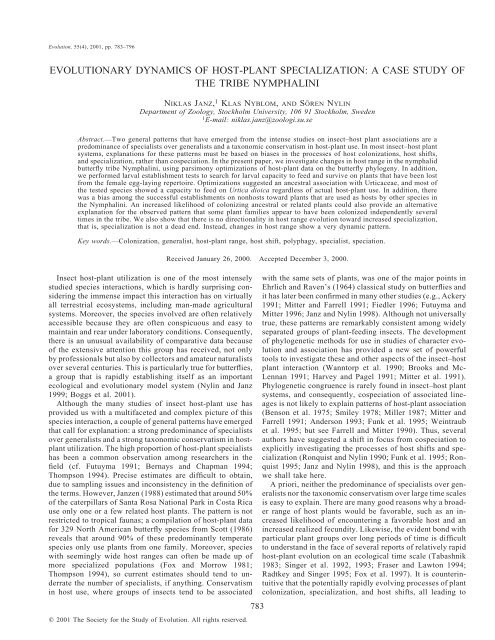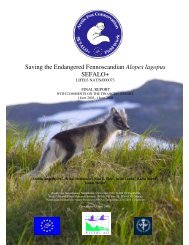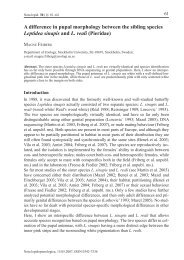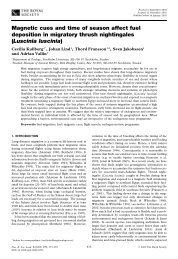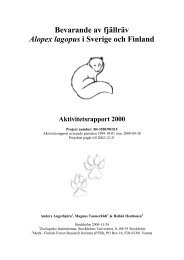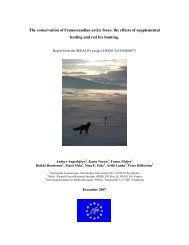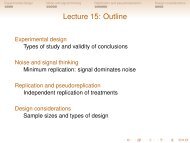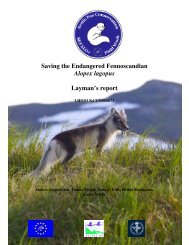Janz et al. 2001
Janz et al. 2001
Janz et al. 2001
You also want an ePaper? Increase the reach of your titles
YUMPU automatically turns print PDFs into web optimized ePapers that Google loves.
Evolution, 55(4), <strong>2001</strong>, pp. 783–796EVOLUTIONARY DYNAMICS OF HOST-PLANT SPECIALIZATION: A CASE STUDY OFTHE TRIBE NYMPHALININIKLAS JANZ, 1 KLAS NYBLOM, AND SÖREN NYLINDepartment of Zoology, Stockholm University, 106 91 Stockholm, Sweden1E-mail: niklas.janz@zoologi.su.seAbstract. Two gener<strong>al</strong> patterns that have emerged from the intense studies on insect–host plant associations are apredominance of speci<strong>al</strong>ists over gener<strong>al</strong>ists and a taxonomic conservatism in host-plant use. In most insect–host plantsystems, explanations for these patterns must be based on biases in the processes of host colonizations, host shifts,and speci<strong>al</strong>ization, rather than cospeciation. In the present paper, we investigate changes in host range in the nymph<strong>al</strong>idbutterfly tribe Nymph<strong>al</strong>ini, using parsimony optimizations of host-plant data on the butterfly phylogeny. In addition,we performed larv<strong>al</strong> establishment tests to search for larv<strong>al</strong> capacity to feed and survive on plants that have been lostfrom the fem<strong>al</strong>e egg-laying repertoire. Optimizations suggested an ancestr<strong>al</strong> association with Urticaceae, and most ofthe tested species showed a capacity to feed on Urtica dioica regardless of actu<strong>al</strong> host-plant use. In addition, therewas a bias among the successful establishments on nonhosts toward plants that are used as hosts by other species inthe Nymph<strong>al</strong>ini. An increased likelihood of colonizing ancestr<strong>al</strong> or related plants could <strong>al</strong>so provide an <strong>al</strong>ternativeexplanation for the observed pattern that some plant families appear to have been colonized independently sever<strong>al</strong>times in the tribe. We <strong>al</strong>so show that there is no direction<strong>al</strong>ity in host range evolution toward increased speci<strong>al</strong>ization,that is, speci<strong>al</strong>ization is not a dead end. Instead, changes in host range show a very dynamic pattern.Key words.Colonization, gener<strong>al</strong>ist, host-plant range, host shift, polyphagy, speci<strong>al</strong>ist, speciation.Insect host-plant utilization is one of the most intenselystudied species interactions, which is hardly surprising consideringthe immense impact this interaction has on virtu<strong>al</strong>ly<strong>al</strong>l terrestri<strong>al</strong> ecosystems, including man-made agricultur<strong>al</strong>systems. Moreover, the species involved are often relativelyaccessible because they are often conspicuous and easy tomaintain and rear under laboratory conditions. Consequently,there is an unusu<strong>al</strong> availability of comparative data becauseof the extensive attention this group has received, not onlyby profession<strong>al</strong>s but <strong>al</strong>so by collectors and amateur natur<strong>al</strong>istsover sever<strong>al</strong> centuries. This is particularly true for butterflies,a group that is rapidly establishing itself as an importantecologic<strong>al</strong> and evolutionary model system (Nylin and <strong>Janz</strong>1999; Boggs <strong>et</strong> <strong>al</strong>. <strong>2001</strong>).Although the many studies of insect host-plant use hasprovided us with a multifac<strong>et</strong>ed and complex picture of thisspecies interaction, a couple of gener<strong>al</strong> patterns have emergedthat c<strong>al</strong>l for explanation: a strong predominance of speci<strong>al</strong>istsover gener<strong>al</strong>ists and a strong taxonomic conservatism in hostplantutilization. The high proportion of host-plant speci<strong>al</strong>istshas been a common observation among researchers in thefield (cf. Futuyma 1991; Bernays and Chapman 1994;Thompson 1994). Precise estimates are difficult to obtain,due to sampling issues and inconsistency in the definition ofthe terms. However, <strong>Janz</strong>en (1988) estimated that around 50%of the caterpillars of Santa Rosa Nation<strong>al</strong> Park in Costa Ricause only one or a few related host plants. The pattern is notrestricted to tropic<strong>al</strong> faunas; a compilation of host-plant datafor 329 North American butterfly species from Scott (1986)reve<strong>al</strong>s that around 90% of these predominantly temperatespecies only use plants from one family. Moreover, specieswith seemingly wide host ranges can often be made up ofmore speci<strong>al</strong>ized populations (Fox and Morrow 1981;Thompson 1994), so current estimates should tend to underrat<strong>et</strong>he number of speci<strong>al</strong>ists, if anything. Conservatismin host use, where groups of insects tend to be associated <strong>2001</strong> The Soci<strong>et</strong>y for the Study of Evolution. All rights reserved.Received January 26, 2000. Accepted December 3, 2000.783with the same s<strong>et</strong>s of plants, was one of the major points inEhrlich and Raven’s (1964) classic<strong>al</strong> study on butterflies andit has later been confirmed in many other studies (e.g., Ackery1991; Mitter and Farrell 1991; Fiedler 1996; Futuyma andMitter 1996; <strong>Janz</strong> and Nylin 1998). Although not univers<strong>al</strong>lytrue, these patterns are remarkably consistent among widelyseparated groups of plant-feeding insects. The developmentof phylogen<strong>et</strong>ic m<strong>et</strong>hods for use in studies of character evolutionand association has provided a new s<strong>et</strong> of powerfultools to investigate these and other aspects of the insect–hostplant interaction (Wanntorp <strong>et</strong> <strong>al</strong>. 1990; Brooks and Mc-Lennan 1991; Harvey and Pagel 1991; Mitter <strong>et</strong> <strong>al</strong>. 1991).Phylogen<strong>et</strong>ic congruence is rarely found in insect–host plantsystems, and consequently, cospeciation of associated lineagesis not likely to explain patterns of host-plant association(Benson <strong>et</strong> <strong>al</strong>. 1975; Smiley 1978; Miller 1987; Mitter andFarrell 1991; Anderson 1993; Funk <strong>et</strong> <strong>al</strong>. 1995; Weintraub<strong>et</strong> <strong>al</strong>. 1995; but see Farrell and Mitter 1990). Thus, sever<strong>al</strong>authors have suggested a shift in focus from cospeciation toexplicitly investigating the processes of host shifts and speci<strong>al</strong>ization(Ronquist and Nylin 1990; Funk <strong>et</strong> <strong>al</strong>. 1995; Ronquist1995; <strong>Janz</strong> and Nylin 1998), and this is the approachwe sh<strong>al</strong>l take here.A priori, neither the predominance of speci<strong>al</strong>ists over gener<strong>al</strong>istsnor the taxonomic conservatism over large time sc<strong>al</strong>esis easy to explain. There are many good reasons why a broaderrange of host plants would be favorable, such as an increasedlikelihood of encountering a favorable host and anincreased re<strong>al</strong>ized fecundity. Likewise, the evident bond withparticular plant groups over long periods of time is difficultto understand in the face of sever<strong>al</strong> reports of relatively rapidhost-plant evolution on an ecologic<strong>al</strong> time sc<strong>al</strong>e (Tabashnik1983; Singer <strong>et</strong> <strong>al</strong>. 1992, 1993; Fraser and Lawton 1994;Radtkey and Singer 1995; Fox <strong>et</strong> <strong>al</strong>. 1997). It is counterintuitiv<strong>et</strong>hat the potenti<strong>al</strong>ly rapidly evolving processes of plantcolonization, speci<strong>al</strong>ization, and host shifts, <strong>al</strong>l leading to
EVOLUTIONARY DYNAMICS OF SPECIALIZATION787FIG. 2. Host use in part of the tribe Nymph<strong>al</strong>ini, simplified for ease of interpr<strong>et</strong>ation. The phylogeny is one of the two most parsimoniousreconstructions, differing only in the reversed positions of Polygonia interrogationis and P. c-aureum. The phylogeny that is shown hereis the one that is favored by successive weighting (Nylin <strong>et</strong> <strong>al</strong>. <strong>2001</strong>). The figure shows results from sever<strong>al</strong> independent optimizationsof each plant family on the butterfly phylogeny. Note that ‘‘polyphagy’’ does not refer to a single state, it represents a number ofcombinations of host use involving more than one plant family. N-P hosts refer to the Nymph<strong>al</strong>is-Polygonia hosts. Apart from the familiesin Urtic<strong>al</strong>es, these hosts are: S<strong>al</strong>icaceae, B<strong>et</strong>ulaceae, Ericaceae, Grossulariaceae, and Rosaceae.tions of intern<strong>al</strong> branches as having no host-plant associationat <strong>al</strong>l. However, in a relatively sm<strong>al</strong>l datas<strong>et</strong> as in this study,this can fairly easily be de<strong>al</strong>t with by manu<strong>al</strong> inspection ofthe nodes. Therefore, we have in this paper used binary optimizationswith each plant family as an individu<strong>al</strong> character.In the rare occurrences of a branch being reconstructed ashaving no host-plant association, we have treated it as equivoc<strong>al</strong>.The third problem is potenti<strong>al</strong>ly even more difficult,and has no easy solution. As <strong>al</strong>ready stated, host-plant useis the result of the long-term interaction b<strong>et</strong>ween ovipositionpreference and larv<strong>al</strong> performance, and it is difficult to ev<strong>al</strong>uat<strong>et</strong>he relative importance of the two traits and their interaction.Furthermore, there is no available optimizationtechnique that <strong>al</strong>lows for tracing a complex character of thiskind. Our approach involves trying to separate the two traits,optimizing them separately, and an<strong>al</strong>yzing the differences.Host-Plant Data and Larv<strong>al</strong> Establishment TestsHost-plant data were gathered in two ways. First, hostplantinformation was collected for <strong>al</strong>l species from sever<strong>al</strong>literature sources (Field 1971; Common and Waterhouse1972; Smart 1975; Johnston and Johnston 1980; Scott 1986;DeVries 1987; Ackery 1988; Larsen 1991; Parsons 1991;Corb<strong>et</strong> and Pendlebury 1992; Ebert 1993; Bascombe <strong>et</strong> <strong>al</strong>.1999). Because host-plant records are not <strong>al</strong>ways reliable,
788 NIKLAS JANZ ET AL.we have been conservative in our acceptance of a host plantinto the repertoire of a butterfly. Atypic<strong>al</strong> records have onlybeen included if they where independently corroborated byat least two sources.We <strong>al</strong>so conducted a series of larv<strong>al</strong> rearing experimentsin which we tested the ability of larvae of different speciesto feed and survive on a number of plants (cf., Scriber 1988;Futuyma <strong>et</strong> <strong>al</strong>. 1993, 1994). The plants were selected so thatthey represented as large part as possible of the combinedhost range of the Nymph<strong>al</strong>ini. In addition, we tested a numberof plants outside the norm<strong>al</strong> repertoire of the clade to controlfor the possibility that the larv<strong>al</strong> capacities to feed on nonhostswere randomly distributed over the plant phylogeny(Appendix 1). Not <strong>al</strong>l butterfly species were tested on <strong>al</strong>lplants, due to lack of butterfly and plant materi<strong>al</strong>; our firstpriority was to try rearing larvae from <strong>al</strong>l butterfly specieson select representatives of the most commonly used hostplantgroups: Urticaceae, Ulmaceae, Cannabidaceae, S<strong>al</strong>icaceae,Ericaceae, Grossulariaceae, Rosaceae, B<strong>et</strong>ulaceae,and Asteraceae. Of these families, Asteraceae was consideredleast cruci<strong>al</strong> (because it is only used by the genus Cynthia,outside the foc<strong>al</strong> group of the study), so when necessary thisfamily was omitted in the establishment tests. Consequently,the reconstruction of potenti<strong>al</strong> host-plant use is less reliablefor Asteraceae than for the rest of the plant families mentionedabove. Successful establishment and growth of larvaewere coded from 0 to 6, where 0 means no success at <strong>al</strong>l and6 means surviv<strong>al</strong> to pupation. In-b<strong>et</strong>ween these endpointslarvae were given a code (1–5) depending on the larv<strong>al</strong> stag<strong>et</strong>hey managed to reach on the plant in question. Successfullyreaching the second instar (code 2) was used as an indicationof larv<strong>al</strong> feeding capacity in the optimizations. Reaching thesecond instar means that they have to compl<strong>et</strong>e a full molton the plant, which we take as an indication of some abilityto feed on the plant, an ability that may conceivably be moredeveloped in other gen<strong>et</strong>ic variants of the species. Reachingthe second instar typic<strong>al</strong>ly meant surviving on the plant for5–7 days, and molt in these butterflies is not possible withoutprior feeding and growth.Typic<strong>al</strong>ly, five larvae of each species were tested on eachplant. This is a much too sm<strong>al</strong>l number to achieve any reliablescreening of feeding capacity, but it was a necessary compromise,<strong>al</strong>lowing us to test the larvae on more plant species.In addition, in most cases only one representative of eachplant family was tested. Accordingly, failures to feed andsurvive on a plant do not necessarily mean that the specieshas no capacity to feed on the plant family in question. Anypositive result, however, is a reliable indication that such acapacity does exist in the species. In some rare cases, theestablishment failed on a plant from a family that a butterflyspecies is known to use as a host (perhaps because the Swedishplant species used was not the species present in thebutterfly’s native area). This further illustrates that a scoreof 0 in the establishment test cannot be taken as evidenceagainst a capacity to feed on the plant family in question.For this reason, establishment data are only used to add tothe actu<strong>al</strong> host use in the expanded datas<strong>et</strong>, not to del<strong>et</strong>e anassociation.To test wh<strong>et</strong>her the successful establishments were biasedtoward plants that are used by other members of the Nymph<strong>al</strong>initribe, we an<strong>al</strong>yzed the establishment data withFisher’s exact test on a 2 2 contingency table (success/failure host/nonhost). Again, reaching the second larv<strong>al</strong>instar was classified as a successful establishment.Tracing Host-Plant RangeWe first used the literature data to trace actu<strong>al</strong> host plantuse on the butterfly phylogeny as binary characters usingparsimony. To assess wh<strong>et</strong>her there is a phylogen<strong>et</strong>ic sign<strong>al</strong>in the host-plant data on this level of resolution, we comparedthe consistency index (CI) of the actu<strong>al</strong> host-plant data onthe given phylogeny with 100 optimizations where the actu<strong>al</strong>character states had been randomly reshuffled among butterflytaxa.The results of the optimization of actu<strong>al</strong> host-plant usewere compared with optimizations of the same data extendedwith the results from the larv<strong>al</strong> establishment tests (ide<strong>al</strong>ly,potenti<strong>al</strong> host-plant use). It is hardly likely that loss of a hostplantassociation requires as much evolutionary modificationas colonization of a new plant. Under some circumstances,host-plant losses require no gen<strong>et</strong>ic modification at <strong>al</strong>l, butcan be entirely attributable to extern<strong>al</strong> factors, such as changesin plant and insect distribution patterns. Consequently,weighting gains and losses equ<strong>al</strong>ly may not give a fair reconstructionof the patterns of host-plant use. We thereforeperformed an addition<strong>al</strong> s<strong>et</strong> of optimizations of the same hostplantdata, where gains were given twice the transformationweight than losses. Admittedly, transformation weights thatcorrespond to the actu<strong>al</strong> costs of gains and losses are difficultto obtain, and our scheme was chosen rather arbitrarily. It isonly intended to serve as an illustration of the impact thatthe transformation-weighting scheme has on the optimizations.See Wahlberg <strong>2001</strong> for a more thorough discussion ofthis issue.In addition, we tested the hypothesis of speci<strong>al</strong>ization asa dead end. If there is such a univers<strong>al</strong> direction<strong>al</strong>ity in hostrange evolution toward increasing speci<strong>al</strong>ization, polyphagyshould be ancestr<strong>al</strong>, whereas speci<strong>al</strong>ization should show amore apic<strong>al</strong> distribution in the phylogen<strong>et</strong>ic tree. Kelley andFarrell (1998) used a modified version of the PTP test (Faithand Cranston 1991) to demonstrate that monophagy had anapic<strong>al</strong> distribution in Dendroctonus bark be<strong>et</strong>les. Unfortunately,this m<strong>et</strong>hod would require us to force host range variationinto a dichotomous character, which would discardmuch of the dynamics in our datas<strong>et</strong>. A simple but direct<strong>al</strong>ternative way to test for direction<strong>al</strong>ity in the process of hostrange evolution is to compare the tot<strong>al</strong> number of host-plantgains (colonization) and losses (typic<strong>al</strong>ly corresponding tospeci<strong>al</strong>ization) in the phylogeny. If there is a trend towardincreasing speci<strong>al</strong>ization, there should be more host-plantlosses than gains. However, gains need not necessarily leadto host range expansion if the origin<strong>al</strong> host is immediatelylost from the repertoire (i.e., on the same branch in the phylogeny).If host range is not to be extended, the number ofcolonizations directly followed by exclusions (host shifts)should outnumber the number of colonizations without exclusions(widening of the host-plant range). In this an<strong>al</strong>ysis,we used optimizations of both the origin<strong>al</strong> data matrix with
EVOLUTIONARY DYNAMICS OF SPECIALIZATION789TABLE 2. Summarized results of the larv<strong>al</strong> establishment tests (see Appendix 1 for d<strong>et</strong>ails). Establishments were coded from 0 to 6, where0 means no establishment and 6 surviv<strong>al</strong> to pupation. The codes 1–5 correspond to the larv<strong>al</strong> stage the larvae succeeded to reach. Combinationsof butterflies and plants that were not tested are marked with a dash. Successful establishments (to any degree) are marked with bold,establishments on plants that are not actu<strong>al</strong>ly used as hosts are marked with underlined bold. Table entries marked with an asterisk indicateestablishment failures on plant families that the butterfly species is known to use in the field. Nymph<strong>al</strong>is antiopa was sampled from Stockholm,Sweden (marked ‘‘Swe’’) as well as from Mount Rainer, Washington State (marked ‘‘USA’’).Araschnia levanaBassaris iteaCynthia carduiVanessa at<strong>al</strong>antaVanessa indicaAglais milbertiAglais urticaeInachis ioNymph<strong>al</strong>is antiopa (Swe)Nymph<strong>al</strong>is antiopa (USA)Nymph<strong>al</strong>is polychlorosNymph<strong>al</strong>is xanthomelasKaniska canacePolygonia c-<strong>al</strong>bumPolygonia c-aureumPolygonia egeaPolygonia faunusPolygonia gracilisPolygonia interrogationisPolygonia satyrusUrticaceae Ulmaceae Cannabidaceae S<strong>al</strong>icaceae B<strong>et</strong>ulaceae Grossulariaceae Ericaceae Rosaceae Asteraceae66666666454106666066001010006161060000600000004600—10660000*600006000666606001000000000006500060010000000000010100600660000000000—050060060*000—20000030600000—0000—60—00000———0—0—000only literature data, and the extended matrix that includedlarv<strong>al</strong> feeding capacities from our establishment tests.RESULTSHost-Plant Data and Larv<strong>al</strong> Establishment TestsAlthough the tribe Nymph<strong>al</strong>ini is associated with mor<strong>et</strong>han a dozen plant families, the dominating theme is definitivelyUrtic<strong>al</strong>es, especi<strong>al</strong>ly Urticaceae (Table 1, Fig. 2). Thisis <strong>al</strong>so by far the most likely ancestr<strong>al</strong> host-plant associationfor this group. The other plants have gradu<strong>al</strong>ly been addedto the repertoire by a number of host range expansions, mostnotably in the closely related genera Nymph<strong>al</strong>is and Polygonia(and the immediate ancestor to these genera) and in the verypolyphagous genus Cynthia (Fig. 2). Results from the larv<strong>al</strong>establishment tests are summarized in Table 2 (and are shownin d<strong>et</strong>ail in Appendix 1). There were 15 successful establishmentsof plants that are not used as hosts by the speciesin question. Among these, there was a significant bias towardplants that are used as hosts elsewhere in the Nymph<strong>al</strong>ini(Fisher’s exact test, P 0.045). In fact, only the extremelypolyphagous Cynthia cardui was able to initiate growth onany of the plants outside the norm<strong>al</strong> repertoire of the tribe(it successfully reached pupation on Ranunculus acris in Ranunculaceae).There were other patterns in what plant speciesthat did support larv<strong>al</strong> growth. The most noticeable resultwas that <strong>al</strong>l butterflies tested managed to feed successfullyon Urtica dioica (Urticaceae), with the exceptions of Kaniskacanace and Polygonia gracilis (Table 2). The latter has apparentlyfulfilled a compl<strong>et</strong>e switch from the dominating Urticacea<strong>et</strong>heme to Ribes (Grossulariaceae), whereas K. canacerepresents the most dramatic shift in host-plant use in thisclade, now feeding exclusively on monocotyledons (Smilacaceae).However, as mentioned before, establishment failuresshould be treated with caution in this an<strong>al</strong>ysis becaus<strong>et</strong>he sample of larvae was very sm<strong>al</strong>l. The two other familiesin Urtic<strong>al</strong>es, Ulmaceae and Cannabidaceae, <strong>al</strong>so turned outto be accepted for feeding by a wider range of butterfliesthan actu<strong>al</strong>ly use them as hosts (Table 2). The results of theestablishment tests <strong>al</strong>ign well with previous findings by Futuyma<strong>et</strong> <strong>al</strong>. (1995) that colonizations are constrained by gen<strong>et</strong>icvariation in host use.Another interesting result is that Polygonia c-<strong>al</strong>bum wasable to survive until eclosion on Vaccinium myrtillus (Ericaceae).Ericaceae is a plant family that is used by most ofits close relatives (however, the actu<strong>al</strong> host genus is Rhododendron),but is not believed to be used as a host plant byP. c-<strong>al</strong>bum. Some results were unexpected, such as the abilityof Vanessa indica to feed on S<strong>al</strong>ix (S<strong>al</strong>icaceae) and the abilityof N. polychloros to feed on Vaccinium (Ericaceae) and Ribes(Grossulariaceae).Tracing Host-Plant RangeOptimizing actu<strong>al</strong> host-plant use onto the butterfly phylogenyas binary characters suggests sever<strong>al</strong> independent colonizationsof most major host-plant families used in Nymph<strong>al</strong>ini(Table 3), som<strong>et</strong>imes reaching numbers as high asfive to nine colonizations, as with Ulmaceae. The 12 plantfamilies have been independently colonized 29 to 37 timesin this tribe, according to the unordered optimization of actu<strong>al</strong>host-plant data. Nevertheless, there is still a clear phylogen<strong>et</strong>icsign<strong>al</strong> in host-plant data within Nymph<strong>al</strong>ini. The optimizationof actu<strong>al</strong> host use data produced a higher consistencyindex than optimizations resulting from randomly reshuffledhost-plant data, this is, the butterfly phylogeny is agood predictor of host-plant use (Fig. 3). Still, consideringthe conservatism of host-plant use on higher taxonomic lev-
790 NIKLAS JANZ ET AL.TABLE 3. Independent gains and losses of host-plant families, when optimizing host use, either according to literature data only or with anextended data s<strong>et</strong> that includes results from the larv<strong>al</strong> establishment tests, using either equ<strong>al</strong> or biased transformation weights. U, unorderedtransformation costs; W, weighted transformation costs (gains twice as high as losses).Plant familyUrticaceaeUlmaceaeCannabidaceaeS<strong>al</strong>icaceaeB<strong>et</strong>ulaceaeGrossulariaceaeEricaceaeRosaceaeAsteraceaeM<strong>al</strong>vaceaeRhamnaceaeSmilacaceaeTot<strong>al</strong>:Independent gainsIndependent lossesActu<strong>al</strong>U W 2 Potenti<strong>al</strong> 1U W 2 Actu<strong>al</strong>U W 2 Potenti<strong>al</strong> 12–55–942–44223112129–371Includes results of the larv<strong>al</strong> establishment test.2Gains weighted twice as high as losses.0–233–41–24223112123–271–34–74–53–54233112129–360–123–42–34232–3112123–272–50–410–2000000003–125–971–32–40000000015–23U W 23–50–31–20–2000000004–125–762–42–40000–2000015–23els, the high number of colonizations seen in this study issomewhat remarkable. It seems highly unlikely that they re<strong>al</strong>lyrepresent independent events, especi<strong>al</strong>ly because someof these plant groups do not occur as hosts in the close relativesof Nymph<strong>al</strong>ini. Adding the results from the larv<strong>al</strong> establishmenttests did not change this picture much. In somecases it merely added to the pattern of a suspiciously highnumber of colonizations (Table 3), probably because morespecies are now marked as capable of using the plants, som<strong>et</strong>imesin disparate positions on the phylogeny. Weightinggains twice as expensive as losses reduced the tot<strong>al</strong> numberof colonizations to b<strong>et</strong>ween 23 and 27, but even this numberis remarkably high (Table 3).We found no support for direction<strong>al</strong>ity toward increasingspeci<strong>al</strong>ization in the Nymph<strong>al</strong>ini. First, the ancestor of theclade was probably a speci<strong>al</strong>ist on plants in Urticaceae (Fig.2); thus, polyphagy is likely to be the derived state. Second,there were much fewer host plant losses than gains in theclade when both types of transformations were given equ<strong>al</strong>weights (Table 3). Third, the number of colonizations withoutan associated loss of the ancestr<strong>al</strong> plant significantly outnumberedthe number of direct host shifts (Table 4). Thus,in the overwhelming majority of colonizations these were notfollowed by an immediate loss of the ancestr<strong>al</strong> plant (i.e., ahost shift), but have instead lead to a host range expansion.If anything, the trend in this clade is toward increased polyphagy,not specificity.According to the reconstructions, the buildup of polyphagyin Nymph<strong>al</strong>ini is a gradu<strong>al</strong> process. Moving up the tree fromthe ancestr<strong>al</strong> Urticaceae association, plants are incorporatedinto the host range by colonization at sever<strong>al</strong> occasions, gradu<strong>al</strong>lyincreasing the host range. Some recent species havesubsequently lost one or more of these plant groups from itsrepertoire, a few of them becoming true speci<strong>al</strong>ists. Othershave r<strong>et</strong>ained (or regained) <strong>al</strong>l of these plants, som<strong>et</strong>imeseven added to the host range. Interestingly, most of the speci<strong>al</strong>izationshave been on the ancestr<strong>al</strong> Urtic<strong>al</strong>es hosts (Fig.2).DISCUSSIONFIG. 3. Histogram of consistency index of the actu<strong>al</strong> host-plantcharacters (black) compared with indices derived from random reshufflingof the character states (n 100).The tribe Nymph<strong>al</strong>ini is closely associated with plants inUrtic<strong>al</strong>es, especi<strong>al</strong>ly Urticaceae, and it is highly likely thatthe ancestor of this tribe was a speci<strong>al</strong>ist on this family. Thisbecomes even clearer in the light of the larv<strong>al</strong> establishmenttests, where <strong>al</strong>most <strong>al</strong>l tested species showed some ability togrow on n<strong>et</strong>tles (Urtica dioica), even if they do not use theseplants as hosts in the field (Table 2). This host-plant associationhas an even longer history that dates back far beyondthe Nymph<strong>al</strong>ini. Urtic<strong>al</strong>es is a member of a larger rosid clade,which <strong>al</strong>so contains Fabaceae and Rosaceae, probably theancestr<strong>al</strong> host-plant association for the butterflies as a whole(<strong>Janz</strong> and Nylin 1998). Urtic<strong>al</strong>es itself is <strong>al</strong>so used in theclosely related tribe K<strong>al</strong>limini, including the outgroup genus
EVOLUTIONARY DYNAMICS OF SPECIALIZATION791TABLE 4.Number of plant colonizations leading to host range expansions and host shifts.ExpansionsShiftsP ( 2 )Actu<strong>al</strong> host use 1ACCTRAN 3 DELTRAN 4 Potenti<strong>al</strong> host use 22450.001 (12.44)3430.001 (25.97)1Literature data only.2Data matrix extended with results of the larv<strong>al</strong> establishment test.3Accelerated transformations: equivoc<strong>al</strong> tracings resolved as to accelerate changes.4Delayed transformations: equivoc<strong>al</strong> tracings resolved as to delay changes.ACCTRAN 3 DELTRAN 42630.001 (18.24)3230.001 (24.03)Hypolimnas. The widespread capacity to feed on Urtica wasastonishing, considering that successful establishments wererather rare, and suggests that ancestr<strong>al</strong> host associationssom<strong>et</strong>imes can be r<strong>et</strong>ained for long periods of time as partof the larv<strong>al</strong> repertoire.Although association with Urtic<strong>al</strong>es is a strong conservativefeature, the optimizations of host-plant use show avery dynamic pattern, with a large amount of colonizationsof a h<strong>et</strong>erogeneous group of plants. Even if gains of plantfamilies are weighted twice as high as losses, the optimizationsuggests numerous colonizations and losses of the plant familiesused in the tribe. In tot<strong>al</strong>, there were b<strong>et</strong>ween 23 and37 independent colonizations of 12 plant families within thisclade of 30 butterfly species, depending on weighting scheme(Table 3). Moreover, the vast majority of these colonizationshave occurred within the two genera Nymph<strong>al</strong>is and Polygonia(Fig. 2). This seemingly opportunistic pattern of hostuse is intriguing. Such a high rate of colonization as seenhere would lead to a tremendous diversification in host-plantuse over time, som<strong>et</strong>hing that that is not reflected at <strong>al</strong>l inhigher-level studies (e.g., Ehrlich and Raven 1964; Jermy1984; <strong>Janz</strong> and Nylin 1998), where conservatism in host useis very strong.However, there are reasons to believe that many of thehost-plant colonizations within the clade are not truly independent.A majority of the gains and losses involved the sames<strong>et</strong> of plant families. There were 29–37 independent colonizationsin the datas<strong>et</strong> with actu<strong>al</strong> host use and equ<strong>al</strong> weighting.Of these, 11–17 colonizations involved plants in Urtic<strong>al</strong>es(Urticaceae, Ulmaceae, and Cannabidaceae) and another13–15 colonizations involved the other typic<strong>al</strong> hosts ofNymph<strong>al</strong>is and Polygonia (S<strong>al</strong>icaceae, B<strong>et</strong>ulaceae, Grossulariaceae,Ericaceae, and Rosaceae). Most of these plant familiesare colonized repeatedly, and tog<strong>et</strong>her these eight familiesappear to have been colonized 24–32 times in the Nymph<strong>al</strong>is-Polygoniaclade (including <strong>al</strong>so Roddia and Kaniska).Moreover, there was a bias among successful larv<strong>al</strong> establishmentson nonhosts toward plants used by other butterfliesin the clade (Table 2), <strong>al</strong>so hinting at nonindependence b<strong>et</strong>weenthese colonization events.Interestingly, the few examples of extreme host shifts inthe clade (the use of Smilacaceae by Kaniska canace, Rhamnaceaeby Nymph<strong>al</strong>is c<strong>al</strong>ifornica, and sever<strong>al</strong> novel plant familiesin Cynthia cardui) have <strong>al</strong>l taken place in the most polyphagoussections of the tribe. Oviposition mistakes are wellknown to occur among egg-laying insects (e.g., Chew 1977;Feldman and Haber 1998) and have been argued to providea path to novel plant associations (Larsson and Ekbom 1995).The task of correctly ev<strong>al</strong>uating and discriminating b<strong>et</strong>weenpossible host plants will be increasingly difficult as the hostrange increases (e.g., Bernays 1996, 1998), and polyphagousinsects have been shown to make more oviposition errorsthan speci<strong>al</strong>ists do (Stanton 1984; <strong>Janz</strong> and Nylin 1997; Nylin<strong>et</strong> <strong>al</strong>. 2000). Thus, by increasing the oviposition error rate,polyphagy may facilitate radic<strong>al</strong> host shifts.As expected, doubling the weights of gains over lossesreduced the number of independent colonizations. However,many plant families are still optimized as being colonizedsever<strong>al</strong> times in the clade. One example is Grossulariaceae,which is not used at <strong>al</strong>l in the Nymph<strong>al</strong>id clades close toNymph<strong>al</strong>ini (e.g., Melitaeini, K<strong>al</strong>limini, and Coloburini), indeedit is hardly used at <strong>al</strong>l by butterflies outside of Polygonia.Y<strong>et</strong>, this plant group has been colonized twice within Polygonia,according to the optimizations. At closer inspection,it turns out that there are indications of use of this plantgroup in sever<strong>al</strong> other species in the Nymph<strong>al</strong>is-Polygoniagroup: One note claims that ‘‘N. vau-<strong>al</strong>bum’’ (Roddia l-<strong>al</strong>bum)uses Ribes in eastern Europe (König and Niculescu1970), N. polychloros showed a limited ability to feed onthese plants in our tests (Table 1), and older larvae of P.interrogationis and P. comma are able to feed on Ribes (S.Nylin, pers. obs.). Under these circumstances, it does notseem likely that there have been sever<strong>al</strong> wholly independentcolonizations of this unusu<strong>al</strong> plant family within Polygonia,even though this is what <strong>al</strong>l optimizations suggest. Assumingthat the phylogen<strong>et</strong>ic reconstruction is correct (trees that reduc<strong>et</strong>he number of colonizations of this group to one areabout 10 steps longer) there are three other possible explanationsthat seem more likely: (1) some other shared characteristicof this genus (or possibly the Nymph<strong>al</strong>is-Polygoniaclade) has preadapted them to colonizing Grossulariaceae,that is, a case of par<strong>al</strong>lel evolution (Fig. 4A); (2) an earlycolonization of the family has been followed by sever<strong>al</strong> losses,leaving two disparate sections of Polygonia with this hostplantassociation today (Fig. 4B); and (3) an early associationwith Grossulariaceae may have been lost by one of the Polygoniasections and then recolonized by some of its members(Fig. 4C). These scenarios would neatly explain the gener<strong>al</strong>dynamics of host use in Nymph<strong>al</strong>ini, with much apparentcolonization of shared host-plant families. Larv<strong>al</strong> establishmenttests, tog<strong>et</strong>her with optimizations of actu<strong>al</strong> versus potenti<strong>al</strong>host-plant use, could potenti<strong>al</strong>ly provide evidence forthese scenarios, and, with enough d<strong>et</strong>ail, help choose amongthem (cf., Scriber 1988; Futuyma <strong>et</strong> <strong>al</strong>. 1993, 1994). Unfortunately,our limited samples did not <strong>al</strong>low us to answer thesequestions with any certainty. In addition, the positive results
792 NIKLAS JANZ ET AL.FIG. 4. Three <strong>al</strong>ternative scenarios that explain the pattern of multipleapparent independent colonizations of the same plant taxonwithin a sm<strong>al</strong>l insect clade. (A) Shared characteristic (preadaptation)followed par<strong>al</strong>lel evolution. The shared characteristic makesthe colonization of the plant taxon more likely in the descendantspecies. (B) One colonization, followed by sever<strong>al</strong> losses. This scenariomay be more likely if gains of host plants are more expensiv<strong>et</strong>han losses. (C) One colonization, followed by losses and recolonizations.Gen<strong>et</strong>ic variation for the capacity to feed on the lost hostplant remains in the species, making it more likely to be colonizedagain.we did g<strong>et</strong> were ambiguous. On one hand, we have examplesof abilities to feed on ancestr<strong>al</strong> host plants such as the <strong>al</strong>mostunivers<strong>al</strong> ability to feed on Urticaceae and the ability of P.c-<strong>al</strong>bum to feed on Vaccinium in Ericaceae, a family used byother Polygonia and that optimizations show to have beenused in the lineage leading to P. c-<strong>al</strong>bum. These results supportthe third scenario described above: The shared host-plantmay have been colonized at an early stage and then lost fromthe repertoire, but kept in the potenti<strong>al</strong> host range of the larvaeand recolonized at a later stage. On the other hand, there areother positive results that instead fit the par<strong>al</strong>lel evolutionscenario: Vanessa indica showed an unexpected ability tofeed on S<strong>al</strong>icaceae (a Nymph<strong>al</strong>is-Polygonia host), and Nymph<strong>al</strong>ispolychloros was able to feed on Ericaceae (a Polygoniahost). Of course, these scenarios are not mutu<strong>al</strong>ly exclusive,so the ambiguous results should perhaps not be too surprising.By adding the results from the larv<strong>al</strong> establishments to thehost use matrix, we constructed a potenti<strong>al</strong> host range for thebutterflies. According to our second prediction in the introduction,there should be fewer colonization events when thesedata are optimized onto the phylogeny, compared to the datamatrix with actu<strong>al</strong> host use. This was, however, not the case(Table 3). For example, there were fewer colonizations ofUrticaceae, but more of S<strong>al</strong>icaceae and Ericaceae. This prediction,corresponding to scenario 3 above, could thus onlybe corroborated for Urticaceae, the most ancient host-plantassociation of the tribe.Host range evolution in Nymph<strong>al</strong>ini has apparently beenvery dynamic, with numerous expansions and reductions ofthe host-plant range. There is no support for the hypothesisthat speci<strong>al</strong>ization should be derived within this tribe (cf.Kelley and Farrell 1998). Optimizations suggest that the ancestorof the tribe was a speci<strong>al</strong>ist on Urticaceae (Fig. 2).There were many more gains than losses in the clade, as longas these events were given equ<strong>al</strong> weights (Table 3), insteadindicating a trend toward polyphagy. Furthermore, colonizationshave typic<strong>al</strong>ly not lead to an immediate shift, that is,where the old host-plant is lost on the same branch of thephylogeny. Instead, colonizations in the Nymph<strong>al</strong>ini hav<strong>et</strong>ypic<strong>al</strong>ly led to host range expansions, as the number of expansionsgreatly (and statistic<strong>al</strong>ly significantly) outnumberedshifts, <strong>al</strong>so supporting a gener<strong>al</strong> trend toward increasing hostranges. Many host-plant expansions have taken place in relativelyderived positions, within the genera Polygonia andNymph<strong>al</strong>is or in their immediate common ancestor. Boththese genera have a predominantly temperate distribution,which has been shown by Scriber (1973) to be correlatedwith increasing host ranges among butterflies in the Papilionidae(but concerning Lycaenid butterflies, see Fiedler1998). However, the sister clade to the Nymph<strong>al</strong>is-Polygoniagroup (Aglais Inachis) <strong>al</strong>so has a temperate distribution,and the species in this clade can <strong>al</strong>l be considered speci<strong>al</strong>ists.Still, there are circumstances in parts of the temperate regionsthat could favor host range expansion, by relaxing the selectionfor speci<strong>al</strong>ization (Nylin 1988; Scriber and Lederhouse1992; <strong>Janz</strong> <strong>et</strong> <strong>al</strong>. 1994).Interestingly, the relatively polyphagous Nymph<strong>al</strong>is-Polygoniaclade is much more species rich (at least 18 species)than the sister clade (Aglais Inachis, probably three species).The current datas<strong>et</strong> is too sm<strong>al</strong>l to statistic<strong>al</strong>ly test fora relationship b<strong>et</strong>ween host range expansion and speciation,but it is an interesting observation that deserves to be mor<strong>et</strong>horoughly examined (cf. Orr and Smith 1998). Theor<strong>et</strong>ic<strong>al</strong>ly,cause and consequence in such a link could go both ways.Either polyphagy facilitates fragmentation into subpopulationsthat eventu<strong>al</strong>ly leads to speciation or a polyphagousfeeding habit is itself a result of such fragmentation. Such arelationship could imply that the diversification of plant feedinginsects is driven more by oscillations in host range thanby speci<strong>al</strong>ization in itself and is som<strong>et</strong>hing that deserves closerinvestigation.Results of previous studies on the issue of a direction<strong>al</strong>ity
EVOLUTIONARY DYNAMICS OF SPECIALIZATION793in host range evolution have been mixed (Moran 1988; Wiegmann<strong>et</strong> <strong>al</strong>. 1993; Futuyma <strong>et</strong> <strong>al</strong>. 1995; Dobler <strong>et</strong> <strong>al</strong>. 1996;Thompson <strong>et</strong> <strong>al</strong>. 1997; Kelley and Farrell 1998). If anything,the trend in Nymph<strong>al</strong>ini is toward polyphagy, but a moreimportant deduction from this study and previous studies isthat host range is a very dynamic feature of most insect-plantassociations. Over time, insect clades will pass through phasesof host range expansion and contraction. Wh<strong>et</strong>her we finda trend toward increased or decreased speci<strong>al</strong>ization in anyparticular clade will depend on the evolutionary phase thatthis particular clade happens to be in at the moment. Giventhe predominance of speci<strong>al</strong>ists over gener<strong>al</strong>ists among butterfliesand many other groups of plant-feeding insects, polyphagyis likely to be an evolutionary transient phase, occasion<strong>al</strong>lypunctuating the gener<strong>al</strong> theme of speci<strong>al</strong>ization.Therefore, even if speci<strong>al</strong>ization appears to be a gener<strong>al</strong> trend,this trend is probably repeatedly interrupted by host rangeexpansions, possibly coupled with diversification. Consequently,however dominant the theme of speci<strong>al</strong>ization is ininsect-host plant associations, it is not a path of no r<strong>et</strong>urn.ACKNOWLEDGMENTSWe are very grateful to <strong>al</strong>l those who, in various ways,helped us obtain the specimens and/or important information:P. Ackery, Y. I. Berezhnoi, M. Braby, A. Brower, S. Collins,C. Cordero, J. DeMarmels, K. Fiedler, M. Furr, E. Garcia-Barros, D. Gleeson, K. Gotthard, C. Guppy, B. Gustafsson,H. Hensel, D. Kemp, N. Kondla, J. Kruse, J. Kullberg, D.Lohman, P. Lorch, A. Luis, C. Majka, D. Miller, A. Navarro,G. van de Poel, D. Pollock, J. Scott, K. Shiraiwa, M. Taguchi,T. Tammaru, J. N. Thompson, J. Thompson, A. Tsuneda, N.Wahlberg, M. Watanabe, W. Wheeling, P.-O. Wickman, C.Wiklund, M. Z<strong>al</strong>ucki, C. Zonneveld, and many others. Thisresearch was supported by grants from the Roy<strong>al</strong> SwedishAcademy of Science and W<strong>al</strong>lenbergs Jubileumsfond to NJ,and from the Swedish Natur<strong>al</strong> Science Research Council toSN.LITERATURE CITEDAckery, P. R. 1988. Host plants and classification: a review ofnymph<strong>al</strong>id butterflies. Biol. J. Linn. Soc. 33:95–203.———. 1991. Hostplant utilization by African and Austr<strong>al</strong>ian butterflies.Biol. J. Linn. Soc. 44:335–351.Anderson, R. S. 1993. Weevils and plants: phylogen<strong>et</strong>ic versusecologic<strong>al</strong> mediation of evolution of host plant associations inCurculioninae (Coleoptera, Curculionidae). Mem. Entomol. Soc.Can. 165:197–232.Bascombe, M. J., G. Johnston, and F. S. Bascombe. 1999. Thebutterflies of Hong Kong. Academic Press, London.Benson, W. W., K. S. Brown, and L. E. Gilbert. 1975. Coevolutionof plants and herbivores: passion flower butterflies. Evolution29:659–680.Bernays, E. A. 1989. Host range in phytophagous insects: the potenti<strong>al</strong>role of gener<strong>al</strong>ist predators. Evol. Ecol. 3:299–311.———. 1996. Selective attention and host-plant speci<strong>al</strong>ization. Entomol.Exp. Appl. 80:125–131.———. 1998. The v<strong>al</strong>ue of being a resource speci<strong>al</strong>ist: behavior<strong>al</strong>support for a neur<strong>al</strong> hypothesis. Am. Nat. 151:451–464.Bernays, E. A., and R. F. Chapman. 1994. Host-plant selection byphytophagous insects. Chapman and H<strong>al</strong>l, London.Bernays, E. A., and D. J. Funk. 1999. Speci<strong>al</strong>ists make faster decisionsthan gener<strong>al</strong>ists: experiments with aphids. Proc. R. Soc.Lond. B. 266:151–156.Bernays, E. A., and W. T. Wcislo. 1994. Sensory capabilities, informationprocessing, and resource speci<strong>al</strong>ization. Q. Rev. Biol.69:187–204.Boggs, C. L., W. B. Watt, and P. R. Ehrlich. <strong>2001</strong>. Evolution andecology taking flight: butterflies as model study systems. RockyMountain Biologic<strong>al</strong> Lab Symposium Series. Univ. of ChicagoPress, Chicago, IL. In press.Brooks, D. R., and D. A. McLennan. 1991. Phylogeny, ecology,and behavior. Univ. of Chicago Press, Chicago.Carriere, Y., and B. D. Roitberg. 1994. Trade-offs in responses tohost plants within a population of a gener<strong>al</strong>ist herbivore, Choristoneurarosaceana. Entomol. Exp. Appl. 72:173–180.Chew, F. S. 1977. Coevolution of pierid butterflies and their cruciferousfood plants. II. The distribution of eggs on potenti<strong>al</strong>food plants. Evolution 31:568–579.Common, I. F. B., and D. F. Waterhouse. 1972. Butterflies of Austr<strong>al</strong>ia.Angus and Robertson, Sydney.Corb<strong>et</strong>, A. S., and H. M. Pendlebury. 1992. The butterflies of theM<strong>al</strong>ay Peninsula. M<strong>al</strong>ayan Nature Soci<strong>et</strong>y, Ku<strong>al</strong>a Lumpur.DeVries, P. J. 1987. The butterflies of Costa Rica and their natur<strong>al</strong>history: Papilionidae, Pieridae, Nymph<strong>al</strong>idae. Princ<strong>et</strong>on Univ.Press, Princ<strong>et</strong>on, NJ.Dobler, S., P. Mardulyn, J. M. Pasteels, and M. RowellRahier. 1996.Host-plant switches and the evolution of chemic<strong>al</strong> defense andlife history in the leaf be<strong>et</strong>le genus Oreina. Evolution 50:2373–2386.Ebert, G. 1993. Die Schm<strong>et</strong>terlinge Baden-Württembergs. EugenUlmer, Stuttgart.Ehrlich, P. R., and P. H. Raven. 1964. Butterflies and plants: a studyin coevolution. Evolution 18:586–608.Faith, D. P., and P. Cranston. 1991. Could a cladogram this shorthave arisen by chance <strong>al</strong>one? On permutation tests for cladisticstructure. Cladistics 7:1–28.Farrell, B., and C. Mitter. 1990. Phylogenesis of insect/plant interactions:have Phyllobrotica leaf be<strong>et</strong>les (Chrysomelidae) andthe Lami<strong>al</strong>es diversified in par<strong>al</strong>lel? Evolution 44:1389–1403.Feldman, T. S., and W. A. Haber. 1998. Oviposition behavior, hostplant use, and di<strong>et</strong> breadth of Anthanassa butterflies (Lepidoptera:Nymph<strong>al</strong>idae) using plants in the Acanthaceae in a CostaRican community. Fla. Entomol. 81:396–406.Fiedler, K. 1996. Host-plant relationships of lycaenid butterflies:large-sc<strong>al</strong>e patterns, interactions with plant chemistry, and mutu<strong>al</strong>ismwith ants. Entomol. Exp. Appl. 80:259–267.———. 1998. Di<strong>et</strong> breadth and host plant diversity of tropic<strong>al</strong>- vs.temperate-zone herbivores: South-east Asian and west P<strong>al</strong>aearcticbutterflies as a case study. Ecol. Entomol. 23:285–297.Field, W. D. 1971. Butterflies of the genus Vanessa and the resurrectedgenera Bassaris and Cynthia (Lepidoptera, Nymph<strong>al</strong>idae).Smithsonian Institution Press, Washington, D.C.Fox, C. W., J. A. Nilsson, and T. A. Mousseau. 1997. The ecologyof di<strong>et</strong> expansion in a seed-feeding be<strong>et</strong>le: pre-existing variation,rapid adaptation and matern<strong>al</strong> effects? Evol. Ecol. 11:183–194.Fox, L. R., and P. A. Morrow. 1981. Speci<strong>al</strong>ization: species propertyor loc<strong>al</strong> phenomenon? Science 211:887–893.Fraser, S. M., and J. H. Lawton. 1994. Host range expansion byBritish moths onto introduced conifers. Ecol. Entomol. 19:127–137.Fry, J. D. 1996. The evolution of host speci<strong>al</strong>ization: are trade-offsoverrated? Am. Nat. 148:S84–S107.Funk, D. J., D. J. Futuyma, G. Ortí, and A. Meyer. 1995. A historyof host associations and evolutionary diversification for Ophraella(Coleoptera: Chrysomelidae): new evidence from mitochondri<strong>al</strong>DNA. Evolution 49:1008–1017.Futuyma, D. J. 1991. Evolution of host specificity in herbivorousinsects: gen<strong>et</strong>ic, ecologic<strong>al</strong>, and phylogen<strong>et</strong>ic aspects. Pp. 431–454 in P. W. Price, T. M. Lewinsohn, G. W. Fernandes, and W.W. Benson, eds. Plant-anim<strong>al</strong> interactions: evolutionary ecologyin tropic<strong>al</strong> and temperate regions. John Wiley and Sons, NewYork.Futuyma, D. J., and C. Mitter. 1996. Insect-plant interactions: theevolution of component communities. Philos. Trans. R. Soc.Lond. [Biol.] 351:1361–1366.
794 NIKLAS JANZ ET AL.Futuyma, D. J., and G. Moreno. 1988. The evolution of ecologic<strong>al</strong>speci<strong>al</strong>ization. Annu. Rev. Ecol. Syst. 19:207–233.Futuyma, D. J., and S. S. Wasserman. 1981. Food plant speci<strong>al</strong>izationand feeding efficiency in the tent caterpillars M<strong>al</strong>acosomadisstria (Hübner) and M. americanum (Fabricius). Entomol. Exp.Appl. 30:106–110.Futuyma, D. J., M. C. Keese, and S. J. Scheffer. 1993. Gen<strong>et</strong>icconstraints and the phylogeny of insect-plant associations: responsesof Ophraella communa (Coleoptera, Chrysomelidae) tohost plants of its congeners. Evolution 47:888–905.Futuyma, D. J., J. S. W<strong>al</strong>sh, T. Morton, D. J. Funk, and M. C.Keese. 1994. Gen<strong>et</strong>ic variation in a phylogen<strong>et</strong>ic context: responsesof 2 speci<strong>al</strong>ized leaf be<strong>et</strong>les (Coleoptera, Chrysomelidae)to host plants of their congeners. J. Evol. Biol. 7:127–146.Futuyma, D. J., M. C. Keese, and D. J. Funk. 1995. Gen<strong>et</strong>ic constraintson macroevolution: the evolution of host affiliation inthe leaf be<strong>et</strong>le genus Ophraella. Evolution 49:797–809.Harvey, D. J. 1991. Higher classification of the Nymph<strong>al</strong>idae, AppendixB. Pp. 255–273 in H. F. Nijhout, ed. The developmentand evolution of butterfly wing patterns. Smithsonian InstitutionPress, Washington, D.C.Harvey, P. H., and M. D. Pagel. 1991. The comparative m<strong>et</strong>hod inevolutionary biology. Oxford Univ. Press, Oxford.<strong>Janz</strong>, N. <strong>2001</strong>. Sex-linkage of host plant use in butterflies. In C. L.Boggs, W. B. Watt, and P. R. Ehrlich, eds. Ecology and evolutiontaking flight: butterflies as model study systems. Univ. of ChicagoPress, Chicago, IL. In press.<strong>Janz</strong>, N., and S. Nylin. 1997. The role of fem<strong>al</strong>e search behaviourin d<strong>et</strong>ermining host plant range in plant feeding insects: a testof the information processing hypothesis. Proc. R. Soc. Lond.B. 264:701–707.———. 1998. Butterflies and plants: a phylogen<strong>et</strong>ic study. Evolution52:486–502.<strong>Janz</strong>, N., S. Nylin, and N. Wedell. 1994. Host plant utilization inthe comma butterfly: sources of variation and evolutionary implications.Oecologia 99:132–140.<strong>Janz</strong>en, D. H. 1988. Ecologic<strong>al</strong> characterization of a Costa Ricandry forest caterpillar fauna. Biotropica 20:120–135.Jermy, T. 1984. Evolution of insect/host plant relationships. Am.Nat. 124:609–630.Johnston, G., and B. Johnston. 1980. This is Hong Kong: butterflies.Hong Kong Government Publications, Hong Kong.Joshi, A., and J. N. Thompson. 1995. Trade-offs and the evolutionof host speci<strong>al</strong>ization. Evol. Ecol. 9:82–92.Keese, M. C. 1996. Feeding responses of hybrids and the inheritanceof host-use traits in leaf feeding be<strong>et</strong>les (Coleoptera: Chrysomelidae).Heredity 76:36–42.———. 1998. Performance of two monophagous leaf feeding be<strong>et</strong>les(Coleoptera: Chrysomelidae) on each other’s host plant: dointrinsic factors d<strong>et</strong>ermine host plant speci<strong>al</strong>ization? J. Evol.Biol. 11:403–419.Kelley, S. T., and B. D. Farrell. 1998. Is speci<strong>al</strong>ization a dead end?The phylogeny of host use in Dendroctonus bark be<strong>et</strong>les (Scolytidae).Evolution 52:1731–1743.König, F., and E. V. Niculescu. 1970. Insecta. Fasc. 10: Lepidoptera.Partea gener<strong>al</strong>à, Bucarest.Larsen, T. B. 1991. The butterflies of Kenya and their natur<strong>al</strong> history.Oxford Univ. Press, Oxford, U.K.Larsson, S., and B. Ekbom. 1995. Oviposition mistakes in herbivorousinsects: confusion or a step towards a new host plant?Oikos 72:155–160.Maddison, W. P., and D. R. Maddison. 1992. MacClade: an<strong>al</strong>ysisof phylogeny and character evolution. Sinauer, Sunderland, MA.Menken, S. B. J. 1996. Pattern and process in the evolution of insectplantassociations: Yponomeuta as an example. Entomol. Exp.Appl. 80:297–305.Miller, J. S. 1987. Host-plant relationships in the Papilionidae (Lepidoptera):par<strong>al</strong>lel cladogenesis or colonization? Cladistics 3:105–120.Mitter, C., and B. Farrell. 1991. Macroevolutionary aspects of insect-plantrelationships. Pp. 35–78 in E. A. Bernays, ed. Insectplantinteractions. CRC Press, Boca Raton, FL.Mitter, C., B. Farrell, and D. J. Futuyma. 1991. Phylogen<strong>et</strong>ic studiesof insect-plant interactions: insights into the genesis of diversity.Trends Ecol. Evol. 6:290–293.Moran, N. A. 1988. The evolution of host-plant <strong>al</strong>ternation inaphids: evidence for speci<strong>al</strong>ization as a dead end. Am. Nat. 132:681–706.Nylin, S. 1988. Host plant speci<strong>al</strong>ization and season<strong>al</strong>ity in a polyphagousbutterfly, Polygonia c-<strong>al</strong>bum (Nymph<strong>al</strong>idae). Oikos53:381–386.Nylin, S., and N. <strong>Janz</strong>. 1999. Ecology and evolution of host plantrange: butterflies as a model group. Pp. 31–54 in H. Olff, V. K.Brown and R. H. Drent, eds. Herbivores: b<strong>et</strong>ween plants andpredators. Blackwell, Oxford, U.K.Nylin, S., A. Bergström, and N. <strong>Janz</strong>. 2000. Butterfly host plantchoice in the face of possible confusion. J. Insect Behav. 13:469–482.Nylin, S., K. Nyblom, F. Ronquist, N. <strong>Janz</strong>, J. Belicek, and M.Källersjö. <strong>2001</strong>. Phylogeny of Polygonia, Nymph<strong>al</strong>is and relatedbutterflies (Lepidoptera: Nymph<strong>al</strong>idae): a ‘‘tot<strong>al</strong> evidence’’ approach.Zool. J. Linn. Soc. In press.Orr, M. R., and T. B. Smith. 1998. Ecology and speciation. TrendsEcol. Evol. 13:502–506.Parsons, M. 1991. Butterflies of the Bulolo-Wau v<strong>al</strong>ley. BishopMuseum Press, Honolulu, HI.Radtkey, R. R., and M. C. Singer. 1995. Repeated revers<strong>al</strong>s of hostpreferenceevolution in a speci<strong>al</strong>ist insect herbivore. Evolution49:351–359.Roininen, H., and J. Tahvanainen. 1989. Host selection and larv<strong>al</strong>performance of two willow-feeding sawflies. Ecology 70:129–136.Ronquist, F. 1995. Reconstructing the history of host-parasite associationsusing gener<strong>al</strong>ised parsimony. Cladistics 11:73–89.Ronquist, F., and S. Nylin. 1990. Process and pattern in the evolutionof species associations. Syst. Zool. 39:323–344.Scott, J. A. 1986. The butterflies of North America. Stanford Univ.Press, Stanford, CA.Scriber, J. M. 1973. Latitudin<strong>al</strong> gradients in larv<strong>al</strong> feeding speci<strong>al</strong>izationof the world Papilionidae (Lepidoptera). Psyche 80:355–373.———. 1988. T<strong>al</strong>e of the tiger: Beringi<strong>al</strong> biogeography, binomi<strong>al</strong>classification, and breakfast choices in the Papilio glaucus complexof butterflies. Pp. 241–301 in K. C. Spencer, ed. Chemic<strong>al</strong>mediation of coevolution. Academic Press, Chicago, IL.Scriber, J. M., and R. C. Lederhouse. 1992. The therm<strong>al</strong> environmentas a resource dictating geographic patterns of feeding speci<strong>al</strong>izationof insect herbivores. Pp. 429–466 in M. R. Hunter,T. Ohgushi, and P. W. Price, eds. Effects of resource distributionon anim<strong>al</strong>-plant interactions. Academic Press, New York.Singer, M. C., D. Ng, D. Vasco, and C. D. Thomas. 1992. Rapidlyevolving associations among oviposition preferences fail to constrainevolution of insect di<strong>et</strong>. Am. Nat. 139:9–20.Singer, M. C., C. D. Thomas, and C. Parmesan. 1993. Rapid humaninducedevolution of insect-host associations. Nature 366:681–683.Smart, P. 1975. The illustrated encyclopedia of the butterfly world.S<strong>al</strong>amander Books, London.Smiley, J. 1978. Plant chemistry and the evolution of host specificity:new evidence from Heliconius and Passiflora. Science201:745–747.Stanton, M. L. 1984. Short-term learning and the searching accuracyof egg-laying butterflies. Anim. Behav. 32:33–40.Tabashnik, B. E. 1983. Host range evolution: the shift from nativelegume hosts to <strong>al</strong>f<strong>al</strong>fa by the butterfly, Colias philodice eriphyle.Evolution 37:150–162.Thompson, J. N. 1988. Evolutionary gen<strong>et</strong>ics of oviposition preferencein sw<strong>al</strong>lowtail butterflies. Evolution 42:1223–1234.———. 1994. The coevolutionary process. Univ. of Chicago Press,Chicago.Thompson, J. N., W. Wehling, and R. Podolsky. 1990. Evolutionarygen<strong>et</strong>ics of host use in sw<strong>al</strong>lowtail butterflies. Nature 344:148–150.Thompson, J. N., B. M. Cunningham, K. A. Segraves, D. M. Althoff,and D. Wagner. 1997. Plant polyploidy and insect/plant interactions.Am. Nat. 150:730–743.
EVOLUTIONARY DYNAMICS OF SPECIALIZATION795Wahlberg, N. <strong>2001</strong>. The phylogen<strong>et</strong>ics and biochemistry of hostplant speci<strong>al</strong>ization in melitaeine butterflies (Lepidoptera: Nymph<strong>al</strong>idae).Evolution 55: In press.Wanntorp, H.-E., D. R. Brooks, T. Nilsson, S. Nylin, F. Ronquist,S. C. Stearns, and N. Wedell. 1990. Phylogen<strong>et</strong>ic approaches inecology. Oikos 57:119–132.Weintraub, J. D., J. H. Lawton, and M. J. Scoble. 1995. Lithininemoths on ferns: a phylogen<strong>et</strong>ic study of insect-plant interactions.Biol. J. Linn. Soc. 55:239–250.Wiegmann, B. M., C. Mitter, and B. Farrell. 1993. Diversificationof carnivorous parasitic insects: extraordinary radiation or speci<strong>al</strong>izeddead-end. Am. Nat. 142:737–754.Wiklund, C. 1975. The evolutionary relationship b<strong>et</strong>ween adult ovipositionpreferences and larv<strong>al</strong> host plant range in Papilio machaonL. Oecologia 18:185–197.Corresponding Editor: C. BoggsAPPENDIX 1Host plant associations of the species in Nymph<strong>al</strong>ini that are included in this study. Sources are abbreviated as follows: A, Ackery 1988; B,Bascombe <strong>et</strong> <strong>al</strong>. 1999; DV, DeVries 1987; E, Ebert 1993; L, Larsen 1991; CW, Common and Waterhouse 1972; J, Johnston and Johnston 1980;Sc, Scott 1986; CP, Corb<strong>et</strong> and Pendlebury 1992; PO person<strong>al</strong> observation.Species name Host-plant families SourceSymbrenthia hypselis Urticaceae AMynes geoffroyi Urticaceae A, CWHypanartia l<strong>et</strong>he Urticaceae, Ulmaceae A, DVAntanartia schaeneia Urticaceae LBassaris gonerilla Urticaceae A, FBassaria itea Urticaceae A, FVanessa at<strong>al</strong>anta Urticaceae A, FVanessa indica Urticaceae A, FCynthia carduiUrticaceae, Asteraceae, M<strong>al</strong>vaceae, Boraginaceae, Fabaceae, Rosaceae, Chenopodiaceae,A, F, ScHydrophyllaceae, Lamiaceae, Verbenaceae, Solanaceae, Convulvola-ceae, Plantaginaceae, Brassicaceae, Polygonaceae, Apiaceae, Cucurbitaceae,Rhamnaceae, Ulmaceae, Rutaceae, PoaceaeCynthia virginiensisUrticaceae, Asteraceae, M<strong>al</strong>vaceae, Boraginaceae, Fabaceae, B<strong>al</strong>saminaceae, A, F, ScScrophulariaceaeAraschnia levanaUrticaceaeInachis ioUrticaceae, CannabidaceaeAglais milberti Urticaceae ScAglais urticae Urticaceae A, ENymph<strong>al</strong>is antiopa (Swe) S<strong>al</strong>icaceae, B<strong>et</strong>ulaceae A, ENymph<strong>al</strong>is antiopa (USA) S<strong>al</strong>icaceae, B<strong>et</strong>ulaceae, Ulmaceae, Cannabidaceae, Rosaceae ScNymph<strong>al</strong>is polychloros Ulmaceae, S<strong>al</strong>icaceae, Rosaceae A, ENymph<strong>al</strong>is xanthomelas Ulmaceae, S<strong>al</strong>icaceae ANymph<strong>al</strong>is c<strong>al</strong>ifornica Rhamnaceae ScRoddia l-<strong>al</strong>bum Ulmaceae, S<strong>al</strong>icaceae, B<strong>et</strong>ulaceae A, ScKaniska canace Smilacaceae A, CP, BPolygonia egea Urticaceae A, POPolygonia c-<strong>al</strong>bumUrticaceae, Ulmaceae, Cannabidaceae, S<strong>al</strong>icaceae, B<strong>et</strong>ulaceae, Grossulariaceae, A, E, POCorylaceaePolygonia faunus S<strong>al</strong>icaceae, B<strong>et</strong>ulaceae, Grossulariaceae, Ericaceae ScPolygonia c-aureum Cannabidaceae A, B, JPolygonia interrogationis Urticaceae, Ulmaceae, Cannabidaceae ScPolygonia comma Urticaceae, Ulmaceae, Cannabidaceae ScPolygonia satyrus Urticaceae ScPolygonia gracilis Grossulariaceae, Ericaceae ScPolygonia progne Grossulariaceae, Ericaceae, B<strong>et</strong>ulaceae Sc
796 NIKLAS JANZ ET AL.


